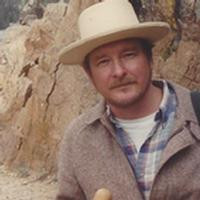

Glenn Whitehead
June 27, 1940 — July 14, 2016
North Austin Location
A charming wit, a sharply observant eye, an intelligent articulation and a relentlessly honest intuition about human behavior suffused Glenn Whitehead's 76 years of making friends and art.
"Even though my life was a mess, I liked to laugh and I loved to hear the laughter of others. I loved to see things. I loved seeing, hearing, touching, tasting. I loved good food and good wine. I could be wonderstruck. Look! A sculpted cumulus cloud, Listen! Wind in a leafy tree. Someone singing. Wow! Light and shadow on my street. I loved being alive on this beautiful planet."
He and Dave Hickey regularly scandalizing the management of UT's student magazine "The Texas Ranger," Glenn drew whimsical armadillos in the text and margins.
"I loved the absurd. That explains why my one splash was as the first cartoon artist who popularized the armadillo, a creature I found amusing, even ridiculous, one which, to my surprise, became a potent symbol for Texas."
It was later cleverly commercialized by others and became disseminated into the meme it is today.
He was born in Houston and was forever grateful to his Bellaire High School teachers Shirley Wily and Norma Henderson. At UT Austin, Barry Schackman taught him how to draw the figure.
"He made a lasting impact on at least two generations of young draughtsmen and painters. I owe him. And I owe Al Buscaglia, the best of all my teachers."
But, his father was a tyrant and a bully and constantly belittled Glenn as a child.
His first wife, Carmalee was speaking to him on the phone when she killed herself with a gunshot to the head.
He never recovered from the death of his beloved older brother Fred.
Bill Helmer said, "He was the man who invented despair."
When in despair, he took solace in Helmer's 1978 Texas Observer Armadillo article wherein Helmer said, "I've met few people as intelligent, creative, sensitive, thoughtful, sensible, rational, perceptive or humorous as Whitehead ... ."
He died July 14, 2016 in Pflugerville, Texas after decades of -declining health marked by increasing consumption of the booze with which he gleefully distracted himself from his demons.
In the early 60s he moved to New York City and took art classes at the Brooklyn Museum, the Arts Student's League and the New School and also sat in classes at NYU and Columbia. He haunted art museums.
"I spent most of my free time in museums, concert halls, libraries and evening and weekend art and writing classes. I did not know I was poor. To the contrary, I thought I was rich."
He obtained an MFA from Stanford in 1972.
He met the "saintly and immaculately cultured" John O'Neil at a college convention, and O'Neil's connections resulted in a job in Wichita, where he taught painting at Wichita State University in the mid seventies.
That art department with painters John Fincher and Steve Berman, printmaker John Boyd and art historians Mira Pajes Merriman, Jim Moore and Stockton Garver, was a brilliant commune of intense artistic creativity and innovation.
He again scandalized management and wrote hilarious letters of recommendation for graduates, including Bruce Pagaz and Larry Webb.
It was in Wichita that he met the lovely and delightful Wanda Gamble. Smart, spirited and talented, she was also the epitome of a classic American pin-up girl.
"I was obsessed with Wanda and it was a magnificent obsession. She remains the light of my life"
In 1976, he painted his entire car with bright flapping flags, black snakes and huge letters reading "Don't Tread on Me" and "Bicentennial Barracuda." He drove around Wichita gleefully shocking and entertaining the population.
"I never believed I should seize the day. I always said 'Squander the day'. Our days are not to set the world on fire but to make a good bacon and tomato sandwich."
He found teaching to be a distraction from his own work. He and Wanda married and moved to Austin and then to Smithville.
"For over forty years, Wanda Gamble and I have been together in one way or the other. Friends, lovers, married, divorced, we shared a studio and painted together, sometimes side-by-side. In my life, Wanda was the big gift."
His paintings and drawings are a rich testament to his intense love of nature and women.
Reuben Saunders showed his work in Wichita. "Glenn would obsess over the tiniest detail of his paintings. He could focus on one little corner that he felt was near perfection, as though the whole was only the means to draw your eye to that one spot. He described every piece he brought to the gallery. He never just handed over a painting it was always a welcome lesson and a window to his soul."
He also had a long and happy relationship with Harrison Itz and his Harris Gallery in Houston. In Austin, he showed with Bill Davis of Davis Gallery.
"It was only later that I realized I had learned so much from looking, just looking. Renoir said 'You don't learn about art from nature, you learn about art in museums.' "
Much of his work vanished into corporate collections. That which survived in the homes of friends gave him greater satisfaction.
"The writer Suzanne Winckler lives in a home full of my work as do Bryan Collier and Matt Swanson. Molly Ivins, that wonderful lady, visited me and bought work even when she was so very ill."
He wrote constantly, making notes, long letters and piquant musings on life and the human condition.
"I frittered away a lot of time writing ... playing with words, beautiful words, whimsy, observations, letters, stories, poems, minutia all"
Smithville Times owners and writers, Bill Bishop and Julie Ardery collected his work and published his writing and drawings.
"I had enough friends. I had enough time. What more could I have wished for? When I died, I was pissed off at no one."
His own handwritten draft obituary was as stringently frank about his life, as is this writing. Additional biographical vita is available on his website - http://www.glennwhitehead.com
"Outwardly my life was dull and static, even meek. But I lived a rich inner life. My dreams were thrilling and extravagant."
He may have felt like a Walter Mitty. But in fact,he was an
extraordinarily generous and humane man whose life deeply affected those who knew him. Their lives are abundantly richer and better.
He seemed to have found such great peace with his world and his friends, that it makes even more vexing the question of why he could never find peace in himself.
He wanted no funeral or memorial service.
He wanted his friends to gather and eat and drink well.
"Bury my ashes where calcium might do some good."



